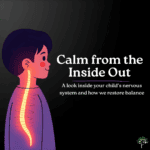(And What To Do About It)
Imagine you’re at the grocery store with your child, and a simple errand quickly spirals into chaos. The fluorescent lights are bright, the music is loud, and the aisles are crowded. Suddenly, your little one clamps their hands over their ears and starts to cry. Tears turn into a full-blown meltdown as you abandon your cart to comfort them.
Scenarios like this – a mall trip ending in tears or a birthday party that becomes overwhelming – might not be “bad behavior” at all. They could be signs that your child is experiencing sensory overload. In fact, sensory processing difficulties are more common than many realize (affecting about 1 in 6 children), yet they are often misunderstood or overlooked.
Let’s walk through why everyday sensations might be so overwhelming for your child – and more importantly, what you can do to help.
What Is Sensory Overload?
Sensory overload occurs when the brain receives more input than it can effectively process, leading a child to feel overwhelmed and distressed. Think of your child’s nervous system like an electrical circuit or a traffic intersection. When too much information comes in all at once – bright lights, loud sounds, new smells, uncomfortable clothes – it’s like an overloaded circuit breaker that trips to prevent damage.
The result is often a “shutdown” or meltdown: crying, screaming, or desperately trying to escape the situation. These reactions are actually a neurological “panic” response to sensations that the rest of us handle without a second thought.
Common signs include:
- Sudden meltdowns or tantrums when faced with certain stimuli
- Avoidance of noisy or crowded places
- Covering ears or eyes
- Aggressive outbursts
- Clinging or hiding in quiet spaces
It’s not that they’re being difficult – their brain is struggling to filter and manage all the incoming signals.
Sensory overload can affect any child, not just those with autism or ADHD. Highly sensitive, anxious, or gifted children may also experience it. It doesn’t necessarily mean a diagnosis – just that their nervous system needs extra support in filtering sensory input.
Why Does It Happen? (When The Nervous System Struggles)
Under normal conditions, the nervous system filters and organizes sensory input. For children with overload issues, that “filter” doesn’t work well – everything feels equally loud, bright, and urgent.
In chiropractic terms, this often involves a subluxation – a slight misalignment in the spine that disrupts communication between the brain and body. Think of it as “static on the phone line.” When this happens, the nervous system can become stuck in fight-or-flight mode, leading to chronic stress and overreaction to normal stimuli.
Possible causes include:
- Difficult pregnancy or birth (C-section, forceps, etc.)
- Nerve stress (especially to the vagus nerve)
- Repeated falls or poor posture
- Chronic inflammation or illness
- Naturally sensitive wiring
This state of imbalance, or dysautonomia, leaves the child’s system overstimulated and unable to self-regulate. The key takeaway: it’s not bad behavior – it’s a neurological imbalance.
What You Can Do About It (Helping Your Child Find Calm)
You can take practical steps to help your child manage sensory overload. It’s not about “fixing” them but about creating safety and calm.
1. Create a Safe, Soothing Space
Set up a quiet corner at home – a tent, beanbag, or cozy nook. Use dim lights, soft textures, and favorite items. Noise-canceling headphones or calming music can help.
2. Practice Deep Breathing (Even If They’re Little)
Teach simple breathing exercises: blow out a candle or pretend to blow bubbles. This signals the brain to relax and reassures your child that they’re safe.
3. Use Sensory Tools and Tricks
Try fidget toys, weighted blankets, chewable necklaces, sunglasses, or hats. These tools help the nervous system feel grounded and in control.
4. Plan Ahead to Minimize Triggers
Go to crowded places during quieter hours. Bring comfort items. Prepare your child with gentle transition warnings (“5 more minutes, then we’ll leave”).
5. Keep a Consistent Routine
Predictability reduces anxiety. Regular meals, bedtimes, and routines create a rhythm of safety and stability.
If challenges persist, consider professional support like pediatric occupational therapy or neurologically focused chiropractic care. Chiropractic adjustments can restore communication between the brain and body, helping children better process sensory input.
Parents often notice improved focus, calmer moods, better sleep, and more tolerance for daily activities after restoring nervous system balance.
Guiding Your Child to Thrive
Understanding sensory overload changes everything. Instead of seeing outbursts as defiance, you begin to see them as communication. Your child isn’t broken – their system just needs balance.
With patience, structure, and professional guidance, your child can move from surviving to thriving. Each small victory – a peaceful grocery trip, a calm bedtime – is progress.
By choosing to understand rather than “fix,” you empower your child to grow in resilience and confidence. And as they do, your family life will become calmer, more joyful, and full of hope.
Sources:
- Sensory Processing Disorder Overview – Vital Wellness Center
- Sprout Family Chiropractic (Dr. Nicole & Dr. Rachel Wong-Homer) – Sensory Processing in Kids
- PX Docs – What Is Sensory Overload?
- Child Mind Institute – Sensory Processing Issues Explained
- Center for Therapeutic Intervention – Signs of Sensory Overload



